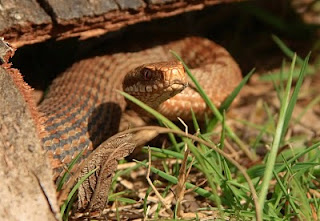I was 8 years old when I saw my first snake in the Forest of Dean. I was out walking in the forest with my parents one day and was approx 15 - 20 feet in front of them when I saw it.
It was stretched out from the verge, basking on the Forestry Commission path and looked enormous! I was young, so this made it look big to me, but I didn't care, I just stood there staring at it!
My mum and dad walked up and my dad said "that's an adder, don't get any closer!"
We stood there and watched as it slowly made its way back into the grass verge and I can remember it like it was yesterday. I now know that we were watching a female adder because of her colour, females are brown and males are black and grey.
It was at that precise moment when my fascination with snakes started. Every time I went out, I would be looking for snakes, nothing else.
I was a teenager when I saw my next snake, a male adder curled around some exposed tree roots. Again my dad helped me find this snake and I still monitor and survey this area for adders and grass snakes today.
You have to learn how to behave around wildlife and snakes are no different. You must treat them with the utmost respect at all times and if you are disturbing them, you must walk away.
When I photograph snakes I am usually between 6 inches and 3 feet away from them, as this is required to capture the detail. They are not restrained in any way and if they felt threatened they would disappear in a flash!
My technique has taken me a long time to perfect so that I don't disturb them. I read their body language and I have even had a male adder lick the front of my camera, another rest his chin on my trainer and another one even pursued me as I was filming him.
This was not aggression, he was just inquisitive. The trick is to get as low to the ground as possible, this way you are not casting a shadow and look less intimidating.
I thank my mum and dad for giving me the guidance to be able to care for and photograph our wildlife, including our wild snakes.
Female Adder - Early 1990's

Rob















